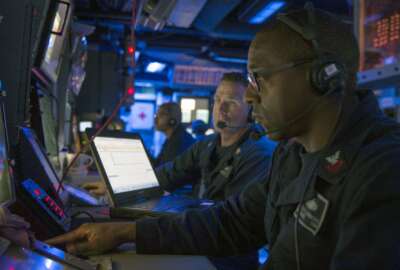Several Navy PEOs put personnel first in modernization efforts
The Navy is solidifying the importance of customer experience. For example, its Program Executive Office for Manpower, Logistics and Business Solutions is making...
The Navy is institutionalizing the importance of customer experience and human centered design as some of its program executive offices (PEO) make pilot programs permanent.
For example, PEO for Manpower, Logistics and Business Solutions (PEO-MLB) focused on customer experience through a pilot study for customer voices on three of its portfolios. It recently signed off to make the study a permanent service, which it will be rolling out in the next few months.
“That will give the fleet and all of the users, once we have it implemented, the ability to provide real-time feedback to the applications and the processes that they’re using,” Brandon Wehler, technical director of PEO-MLB at the Department of the Navy, said at an AFCEA NOVA panel. “So we can get good analytics on it to do some predicti[ons] and fix some issues before they happen. We can also rapidly adjust code or delivery, so as the sailors using it and put it in, [the] next day they come back [and] they have a better experience.”
Wehler said PEO-MLB is just starting to look at human-centered design and is working with stakeholders to figure out the best way to do this for its modernization efforts.
Louis Koplin, executive director of PEO-Digital at the Department of the Navy, said that PEO-Digital is working on a playbook for human-centered design, so it will be doing more of it over the next few months.
Rebecca Gassler, acting director for development and integration and the portfolio management concept pilot lead for PEO Integrated Warfare Systems (PEO-IWS), said her organization has embedded tactics instructors from the different warfighting development centers into the program offices at the Forge — the Navy’s software factory.
“We’re using them as the representative to reach back into their community and give feedback on the fly all the time,” Gassler said.
PEO-IWS sent its first infrastructure-as-a-service kit to sea to help decouple the hardware and software of its combat systems in order to quickly upgrade these systems.
“We’ve decoupled it in preparation of moving to our integrated combat system suite,” Gassler said. “We were able to virtualize our legacy combat system, put it on this infrastructure-as-a-service, [Commercial Off the Shelf (COTS)] based equipment, send it to sea, roll it forward to a tactical test baseline and then roll it back in a fraction of the amount of time. Industry does this all the time, they roll forward and back. We don’t do that in combat systems like system safety, weapons safety does not allow us to do that.”
Over the next six months to two years, the various offices have goals to improve experiences and overall operations. For example, PEO-Digital is working on standing up two centers of excellence inside PEO-Digital for procurement and DevSecOps, respectively.
“When we say DevSecOps…we’re talking about the culture and the process of thinking holistically about the lifecycle of using that operational customer feedback to drive what you’re doing and how you’re doing it,” Koplin said. “This is going to take a while, it’s going to take more than a minute, but that’s one of our core technical competencies as a PEO, is engineering in the industry sense that lifecycle view. Procurement being the other one. Now as an acquisition command, we need to produce excellent procurement results.”
Wehler said that he wants to better utilize resources to improve IT.
“In the government, it’s hard to just stop anything even if it isn’t working well,” Wehler said. “So, I’m doing an assessment of all the tools and all the IT that we have across the entire MLB portfolio. What I want to make sure is that we are doing it smarter as we move forward.”
He said that a challenge to this is that a lot of the underlying infrastructure that PEO-MLB builds its code for and are developing applications for, the office does not manage or control. As a result, it can have requirements or build something, but these may not work on a ship because of the different infrastructure. Wehler said he wants to work with partners to improve this and modernize those infrastructures.
For Gassler at PEO-IWS the Forge software factory could improve by adding its staging environment in there.
“We’ve got to actually virtualize a number of our tactical systems such that we can actually spin up whole strike groups and do testing as we get through force level integration,” she said.
Gassler said to get to an operations concept, things need to be tested in the cloud, which PEO-IWS is having industry help with. She said that testing in the cloud “is going to be key in moving forward and convincing ourselves that it’s ok and the software is ready to push over air to ships.”
She said that getting Forge off the ground can be challenging because of all of the approvals needed before work can begin. Gassler said she also wants to improve how PEO-IWS uses and understands its data. She said upskilling the workforce will also be important to make sure they are ready for new technologies.
Zooming out to the next five years, Koplin said that looking at the pace of change for technology, missions and adversaries is important to design with this in mind.
“We need to design with the expectation of change and not be continually surprised that Windows 11 follows Windows 10 and Windows 12 follows Windows 11,” Koplin said. “We continue to be surprised by that fact.”
Wehler added that using agile delivery will also be important for these tech horizons.
Over at PEO-Digital, Koplin said his office is trying to do a better job indicating what success looks like. Gassler said that industry days can be valuable to connect with industry. Wehler said that PEO-MLB likes utilizing other transaction authorities (OTAs) and the Small Business Innovation Research program, among others, which are important ways to connect with industry. Wehler said that OTAs are a good way to get the ball rolling and move quicker. He added that industry should do its homework.
“I have a lot of different companies that come in and talk to me and there’s a lot of good technology, but they haven’t done the research or they’re not coming in and saying, ‘hey, I have this, this is where we can make a difference for you,’ which would be very beneficial,” Wehler said.
Gassler said she wants tangible deliverables.
“Some of the things no matter what the contract vehicles or the partnership regime is that we’ve got to actually look at what our deliverables are,” she said. “I don’t want paper deliverables. I want models. I want code in pipelines.”
Copyright © 2025 Federal News Network. All rights reserved. This website is not intended for users located within the European Economic Area.
Kirsten Errick covers the Defense Department for Federal News Network. She previously reported on federal technology for Nextgov on topics ranging from space to the federal tech workforce. She has a Master’s in Journalism from Georgetown University and a B.A. in Communication from Villanova University.
Follow @kerrickWFED





